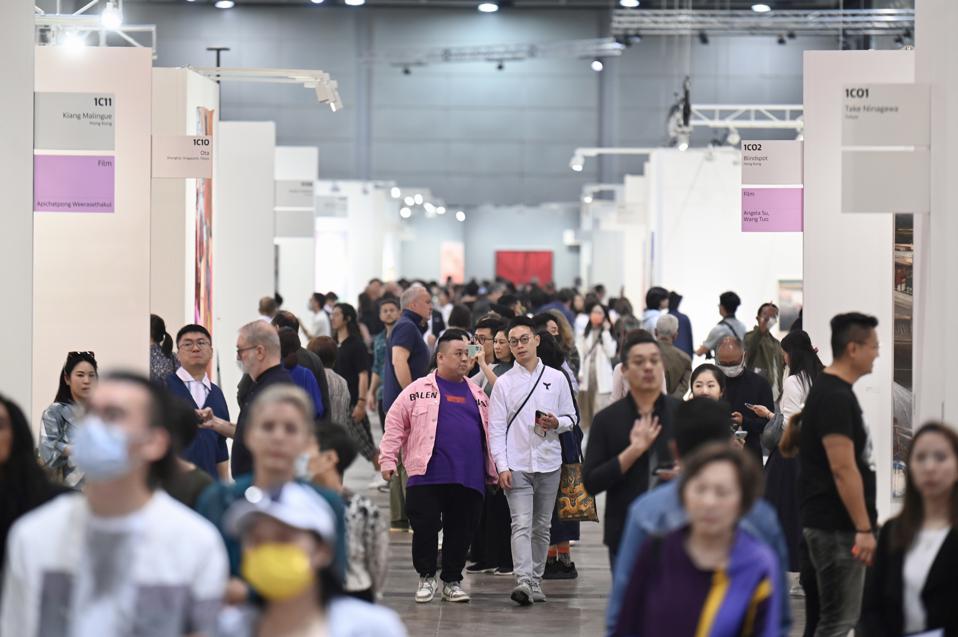Art Basel Hong Kong returned in 2023 with a vengeance. From March 21st to 25th, 86,000 attendees from 70 countries previewed then visited 177 booths, as well as local museums such as M+ and the Hong Kong Palace Museum.
March is a busy month for the international art world. In Maastricht, there is TEFAF (The European Fine Art Fair), and in New York, there is Asia Week New York. The rare dealer or collector will find a way to attend more than one event during the tight March squeeze, not missing an opportunity to reach a new client base or see important inventory.
Art Basel Hong Kong was one of the first cancellations of the pandemic, as February heralded in the ominous signs of a changing world. They transitioned quickly into virtual viewing rooms, in a new tradition that continues today with OVR: Hong Kong, on view through March 27th.
Despite adaptive technologies and a surge in online sales to compensate for the contracted pandemic art market, the international community was eager to return to the fast pace of the prior art climate.
“…There is simply no substitute for being together in person with Asia’s community of wonderfully informed, sophisticated collectors, curators, and patrons,” said Marc Payot, President of Hauser & Wirth, in a comment for the press release. “We are delighted…”
A veteran of the fair, Hauser & Wirth has locations in Hong Kong, Gstaad, St. Moritz, Zurich, London, Los Angeles and New York among others.
Hong Kong fair newcomer Grace Schofield, Co-Director of Union Pacific (London), agreed.
“…People are really glad to be back. We were also pleased to finally have met people in person with whom prior to the fair we’d only communicated with digitally,” she explained. “We’ve met new contacts from Hong Kong and mainland China but also from Korea, Japan, Thailand, Singapore, and Bangladesh. We’ve also connected with several people in London who we’d never actually met.”
All Art Basel fairs, which originated in Switzerland but have since spread to Hong Kong, Miami Beach, and Paris, are currently sponsored by UBS. But the UBS Survey of Global Collecting in 2022 addressed the controversial topic of art in a time of climate change.
“The environmental impact of collecting is a growing concern,” the report stated, “And the surveys showed evidence of increasing awareness of the importance of sustainable options when it comes to purchasing works and the management of collections (from 62% considering these options in 2019 to 77% in 2022).”
The report notes that 57% of high net-worth collectors surveyed are willing to pay a premium for sustainability-focused options that reduce the environmental impact of their purchases, up from 45% in 2019. But 77% said they planned to travel to more fairs, exhibitions, or events overseas in 2023, even as while 63% thought it was important or very important to travel less to reduce their carbon footprint. In other words, there is a contradiction between desire to reduce impact and desire to experience more art.
“All is not well in the global art system,” essayist Olav Velthuis wrote in the report. “Most obviously, globalization has vastly increased the carbon footprint of the arts – although so far, no reliable estimates are available. Just think of the shipping of works of art around the globe for temporary exhibitions, the packed travel schedules of curators, artists, collectors, and dealers to openings of biennials, museum shows, or other global art world events – in the case of the super-rich in their own private jets – or think of the large-scale temporary structures that are erected to host dozens of art fairs globally, and dismantled no more than a week later. The global art system may be insignificant in comparison to the world economy, but given its small size, its carbon footprint is too big.”
When reached for comment, Velthius was humble but firm.
“I’m certainly not the first person to be putting this on the agenda, but it’s a huge topic,” he said. “I honestly think that it’s a huge problem in the art world and the art market.”
He believes the root of the issue is the travel to these events itself, especially high net worth travel in private jets.
“In absolute terms, it’s not a major problem, because the art world is not a major sector in society,” he continued. “If you would see it as a percentage of industries worldwide, it doesn’t make a difference, but in relative terms, it’s a very different picture.”
It is hard to pinpoint exactly how much this suspicion actually results in emissions, however.
“Nobody has the data,” Velthius admitted, “But my prediction would be that if you look at the art market, and the carbon emissions per dollar of art market revenue, then the art market would be extremely high in the ranking.”
There are no easy answers. Regardless of the travel itself, the product, the work of art, is extremely sustainable, often intended to last for generations. The ongoing dialogue between being a consumer of beauty and the rapid-fire pace of global travel remains inevitably complicated for those involved in the art market.
Velthius will be launching his own art database later this month.

